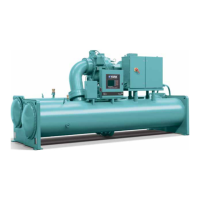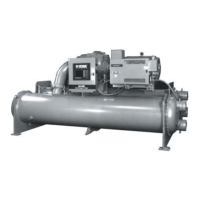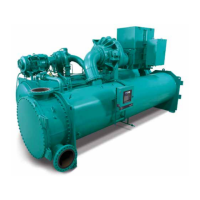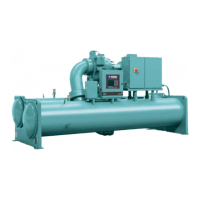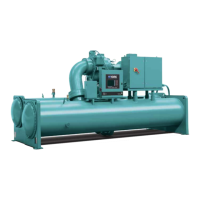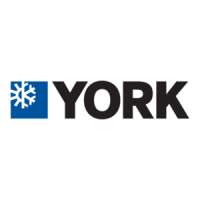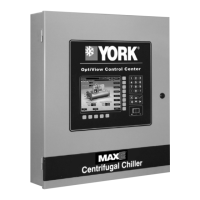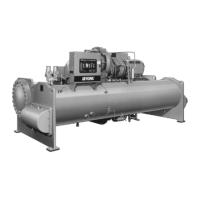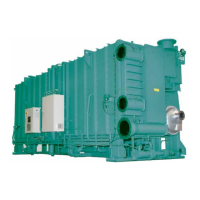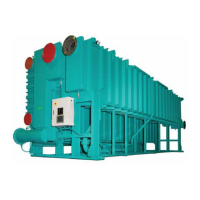YORK INTERNATIONAL 49
FORM 160.49-O1
medium for carrying this residual moisture to the
vacuum pump, nitrogen should be introduced into the
system to bring it to atmospheric pressure and the
indicator temperature will return to approximately am-
FIG. 22 – SATURATION CURVE
bient temperature. Close off the system again, and start
the second evacuation.
The relatively small amount of moisture left will be car-
ried out through the vacuum pump and the tempera-
ture or pressure shown by the indicator should drop
uniformly until it reaches a temperature of 35°F (1.7°C)
or a pressure of 5 mm Hg.
When the vacuum indicator registers this temperature
or pressure, it is a positive sign that the system is
evacuated and dehydrated to the recommended limit.
If this level cannot be reached, it is evident that there
is a leak somewhere in the system. Any leaks must be
corrected before the indicator can be pulled down to
35°F (1.7°C) or 5 mm Hg. in the primary evacuation.
During the primary pulldown, keep a careful watch on
the wet bulb indicator temperature, and do not let it fall
below 35°F (1.7°C). If the temperature is allowed to fall
to 32°F (0°C), the water in the test tube will freeze,
and the result will be a faulty temperature reading.
LD01084
REFRIGERANT CHARGING
To avoid the possibility if freezing liquid within the cooler
tubes when charging an evacuated system, only re-
frigerant vapor from the top of the drum or cylinder
must be admitted to the system pressure until the sys-
tem pressure is raised above the point corresponding
to the freezing point of the cooler liquid. For water, the
pressure corresponding to the freezing point is 57.5
PSIG (396.5 kPa) for R-22 or 8.54 PSIG (58.9 kPa) for
R-134a (at sea level).
While charging, every precaution must be taken to pre-
vent moisture laden air from entering the system. Make
up a suitable charging connection from new copper
tubing to fit between the system charging valve and
the fitting on the charging drum. This connection should
be as short as possible but long enough to permit suf-
ficient flexibility for changing drums. The charging con-
nection should be purged each time a full container of
refrigerant is connected and changing containers should
be done as quickly as possible to minimize the loss of
refrigerant.
Refrigerant may be furnished in drums containing ei-
ther 30, 50, 125 or 1750 lbs. (13.6, 22.7, 56.7 or 793.8
kg) of refrigerant. These drums are not returnable and
they should be stored for future use if it should ever
become necessary to remove refrigeration from the
system.
TABLE 4 – REFRIGERANT CHARGE
SHELL CODES R-22 R-134a R-22 R-134a
Cooler
Con-
denser
(Lbs.) (Kg.)
L L 1350 1340 612 608
L M 1475 1465 669 665
M L 1525 1525 691 691
M M 1625 1625 737 737
M N 1850 1840 839 835
N M 1900 1905 861 864
N N 2125 2125 964 964
N P 2125 2125 964 964
P N 2175 2185 987 991
P P 2175 2185 987 991
P Q 2500 2530 1134 1147
Q P 2550 2560 1157 1161
Q Q 2925 2905 1327 1318
Q R 3250 3250 1474 1465
R Q 3500 3500 1588 1588
R R 3850 3840 1746 1742
